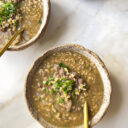Simple Smoky Moutabal with Zahra’s Kitchen Lamb Kibbeh
Moutabal, sometimes known as Baba Ganoush in certain areas, is a beloved Middle Eastern dip primarily crafted from eggplants. The eggplants are typically grilled or roasted until it’s thoroughly charred, bestowing a profound smoky essence upon the dish. The eggplant is pureed with tahini (a sesame seed paste), lemon juice, garlic, and a variety of seasonings, culminating in a savoury, creamy concoction.
There are many ways to prepare Moutabal, but my favourite version was shared to me by my mother-in-law. She add ground walnuts and almonds to introduce a unique richness and a crunchy texture that contrasts nicely with the smooth eggplant, and adds a dash of pomegranate molasses to bring in a subtle sweetness and tang, enhancing the flavours even further.
For this recipe, I char three large eggplants to draw out their natural smokiness, either over a flame or in a hot oven. Then, I mash them with a fork and mix them with tahini paste, ground nuts, optional almonds, fresh herbs and spices, turning it into a rich and creamy spread. I finish it off with a drizzle of olive oil and a squeeze of lemon juice.
This smoky charred eggplant Moutabal, with its layered flavours and textures, is a dish I love to serve alongside Zahra’s Kitchen Lamb Kibbeh. Whether as an elegant appetiser for gatherings or a nutritious snack at home, the combination is a guaranteed crowd-pleaser. The richness of the lamb kibbeh pairs perfectly with the cool smokiness of the moutabal, offering a delightful mix of flavours and textures that will satisfy any taste bud.

Basic Ingredients for Moutabal
Moutabal:
Eggplants: The star of Moutabal, eggplants are grilled or roasted to impart a smoky flavour. They provide a creamy base when mashed and blend well with other ingredients, offering a rich texture and a mild, slightly sweet taste.
Tahini: This sesame seed paste adds a nutty flavour and creamy consistency to the dip. It’s a staple in Middle Eastern cuisine and pairs perfectly with the eggplant.
Lemon Juice: Adds freshness and acidity to balance the richness of the eggplant and tahini, enhancing the overall flavour profile of the dish.
Garlic: Introduces a pungent, spicy flavour that complements the smokiness of the eggplant, adding depth to the dip.
Ground Walnuts and Almonds: These nuts introduce a crunchy texture and a rich, buttery flavour, adding complexity to the Moutabal. They also contribute healthy fats and protein.
Pomegranate Molasses: Offers a tangy sweetness that contrasts with the smoky and nutty flavours, adding a unique taste dimension.
Herbs (Mint and Parsley): Fresh herbs brighten the dish, adding a burst of freshness and colour.
Olive Oil: Enhances the texture, making the dip more luxurious while adding a fruity, peppery note.
Seasonings (Salt, Black Pepper, and Chili Powder): These seasonings are crucial for enhancing and balancing the flavours in the dish.

Zahra’s Kitchen Lamb Kibbeh:

Preparation Tips for Moutabal
- Char the Eggplants Properly: The smokiness is a key flavour in Moutabal, so make sure to char the eggplants thoroughly. If you’re using a grill or gas stove, rotate the eggplants frequently to ensure even charring. If you’re using an oven, broil the eggplants to get a similar charred effect.
- Cooling the Eggplants: After charring, let the eggplants cool before peeling. This step makes it easier to remove the skin and gives the eggplants time to develop their flavour.
- Removing Excess Moisture: After peeling, drain the eggplant flesh on paper towels or a colander to remove excess moisture. This step is crucial to prevent the Moutabal from becoming too watery.
- Tahini Quality: The quality of tahini can vary greatly between brands. Look for one that is smooth, not too bitter, and well mixed (oil shouldn’t be separating excessively). Stir the tahini well before adding it to the mix.
- Balancing Flavors: Adjust the amount of garlic, lemon juice, and seasonings gradually. Taste as you go to ensure the flavours are balanced to your preference. The lemon juice should provide enough acidity to brighten the dip without overpowering the other flavours.
- Texture: Some prefer a chunkier Moutabal, while others like it smooth. Use a fork to mash for a chunkier texture or a food processor or blender for a smoother consistency. However, be careful not to overblend, as it can become too runny.
- Incorporating Nuts: If you’re adding ground walnuts or almonds, ensure they are finely ground so they integrate well into the dip without creating an overly gritty texture.
- Seasoning Adjustments: After combining all ingredients, taste the Moutabal and adjust the seasoning if necessary. Sometimes, a little extra salt, lemon juice, or tahini can make a big difference in the final flavour.
- Letting it Rest: Allow the Moutabal to sit briefly before serving. This resting period lets the flavours meld together and develop more fully.
- Fresh Ingredients: Using fresh lemon juice, garlic, and herbs can significantly impact the freshness and overall taste of your Moutabal.
Serving Tips for Moutabal
- Presentation: Serve Moutabal in a shallow bowl or a plate with a slight dip. Drizzle olive oil over the top, which not only adds flavour but also gives it an appealing gloss. For a touch of colour and texture, sprinkle with chopped herbs like parsley or mint, and consider adding a sprinkle of paprika or sumac for a dash of colour.
- Garnishes: Enhance the visual appeal and taste with garnishes. Pomegranate seeds can add a pop of colour and a burst of tangy sweetness. A sprinkle of toasted nuts (matching the nuts used in the recipe) provides extra crunch and nuttiness.
- Bread Pairings: Moutabal is traditionally served with flatbread. Warm pita bread is a classic choice, but you can also serve it with other types of bread like naan, lavash, or crusty bread slices. Offering a variety of bread can cater to different preferences and make the meal more interesting.
- Vegetable Crudites: For a healthier option, serve Moutabal with a platter of fresh vegetable sticks like carrots, cucumbers, bell peppers, and celery. The freshness of the vegetables pairs well with the creaminess and smokiness of Moutabal.
- Temperature: While Moutabal can be served at room temperature, serving it chilled can be particularly refreshing, especially in warmer climates or seasons. Ensure it’s not too cold, as extreme temperatures can mute the flavors.
- Accompaniments: Moutabal can be part of a larger Middle Eastern or Mediterranean spread, complementing dishes like hummus, tabbouleh, falafel, and stuffed grape leaves. This variety allows guests to enjoy a range of flavors and textures.
- Interactive Serving: Allow guests to customize their servings by providing additional toppings on the side, like extra nuts, herbs, or a bottle of olive oil and pomegranate molasses, so they can adjust the taste to their liking.
storage tips
Cool Before Storing: Allow the Moutabal to cool to room temperature before storing it in the refrigerator. Storing it while still warm can lead to condensation inside the container, making the dip watery.
Airtight Container: Transfer the Moutabal to an airtight container. This will help to preserve its freshness and prevent it from absorbing odors from other foods in the refrigerator.
Olive Oil Layer: Before sealing the container, you can add a thin layer of olive oil on top of the Moutabal. This layer can act as a seal to reduce air exposure and can help to keep the dip moist.
Refrigeration: Store the Moutabal in the refrigerator immediately after it has cooled. The dip should be consumed within 4 to 5 days for the best quality and taste.
Avoid Freezing: Freezing Moutabal is not recommended as it can significantly alter the texture and flavor of the dip. The eggplant can become watery and grainy once thawed.
Moutabal
Ingredients
- 3 large eggplants
- 3 tbsp tahini paste
- 1 tbsp walnuts, finely ground
- 1 tbsp almonds, finely ground (optional)
- 1 tsp mint, finely chopped
- 1 tbsp parsley, finely chopped
- 2 tbsp olive oil
- 1 tbsp pomegranate molasses
- ½ tsp chilli powder, (optional)
- 1 lemon, juiced
- salt
- freshly ground black pepper
Instructions
- Place each eggplant directly on the burner on high flame using a pair of tongs; turn every 5 to 7 minutes until the entire surface is charred. Alternatively, preheat the oven at 250°C, prick the eggplants with a fork, place on a baking sheet and roast in the oven for about 40minutes.
- Once the eggplant has cooked, remove and discard the charred skin. Place the flesh from the eggplants in a large mixing bowl and mash with a fork until smooth. Add the tahini paste, ground walnuts, ground almonds, mint, parsley, olive oil, pomegranate molasses, chilli powder, lemon juice, salt and pepper, and mix the ingredients together. Adjust seasoning and the lemon juice, salt and pepper. Serve with a drizzle of olive oil.
Did you make this recipe?
Tag @cookingwithzahra on Instagram and hashtag it #cookingwithzahra so we can see all the deliciousness!



Edye
This looks delicious, are usually love your recipes, but I feel like this one is it only half of the recipes title… Can you provide us with your recipe for the Lamb Kibbeh as well? Thank you!